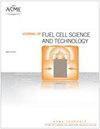Development and Validation of a Uniaxial Nonlinear Viscoelastic Viscoplastic Stress Model for a Fuel Cell Membrane
引用次数: 3
Abstract
Proton exchange membranes (PEMs) in operating fuel cells are subjected to varying thermal and hygral loads while under mechanical constraint imposed within the compressed stack. Swelling during hygrothermal cycles can result in residual in-plane tensile stresses in the membrane and lead to mechanical degradation or failure through thinning or pinhole development. Numerical models can predict the stresses resulting from applied loads based on material characteristics, thus aiding in the development of more durable membrane materials. In this work, a nonlinear viscoelastic stress model based on the Schapery constitutive formulation is used with a viscoplastic term to describe the response of a novel membrane material comprised of a blend of perfluorocyclobutane (PFCB) ionomer and poly(vinylidene fluoride) (PVDF). Uniaxial creep and recovery experiments characterize the time-dependent linear viscoelastic compliance and the fitting parameters for the nonlinear viscoelastic viscoplastic model. The stress model is implemented in a commercial finite element code, abaqus®, to predict the response of a membrane subjected to mechanical loads. The stress model is validated by comparing model predictions to the experimental responses of membranes subjected to multiple-step creep, stress relaxation, and force ramp loads in uniaxial tension.燃料电池膜单轴非线性粘弹性粘塑性应力模型的建立与验证
运行中的燃料电池中的质子交换膜(PEMs)承受着不同的热载荷和湿载荷,同时还受到压缩堆内施加的机械约束。在湿热循环过程中的膨胀会导致膜中残留的平面内拉伸应力,并通过变薄或针孔发展导致机械退化或失效。数值模型可以根据材料特性预测由施加载荷产生的应力,从而有助于开发更耐用的膜材料。在这项工作中,基于Schapery本构公式的非线性粘弹性应力模型与粘塑性术语一起用于描述由全氟环丁烷(PFCB)离聚体和聚偏氟乙烯(PVDF)组成的新型膜材料的响应。单轴蠕变和恢复试验表征了随时间变化的线性粘弹性柔度和非线性粘弹性粘塑性模型的拟合参数。应力模型在商业有限元代码abaqus®中实现,以预测膜在机械载荷下的响应。通过将模型预测与膜在单轴拉伸下经受多步蠕变、应力松弛和力斜坡载荷的实验响应进行比较,验证了应力模型的有效性。
本文章由计算机程序翻译,如有差异,请以英文原文为准。
求助全文
约1分钟内获得全文
求助全文
来源期刊
自引率
0.00%
发文量
0
审稿时长
6-12 weeks
期刊介绍:
The Journal of Fuel Cell Science and Technology publishes peer-reviewed archival scholarly articles, Research Papers, Technical Briefs, and feature articles on all aspects of the science, engineering, and manufacturing of fuel cells of all types. Specific areas of importance include, but are not limited to: development of constituent materials, joining, bonding, connecting, interface/interphase regions, and seals, cell design, processing and manufacturing, multi-scale modeling, combined and coupled behavior, aging, durability and damage tolerance, reliability, availability, stack design, processing and manufacturing, system design and manufacturing, power electronics, optimization and control, fuel cell applications, and fuels and infrastructure.

 求助内容:
求助内容: 应助结果提醒方式:
应助结果提醒方式:


